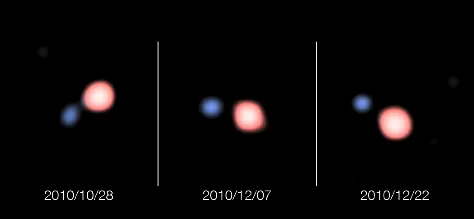
The smaller, hotter star in the double star system SS Leporis is leeching material from its larger, cooler red giant companion
Credit: ESO/PIONIER/IPAG
Scientists have combined the light from four VLT telescopes to create the sharpest image yet of a star that has lost most of its material to a 'vampire' companion.
By combining the four telescopes, European Southern Observatory scientists were able to create a 'virtual telescope' 130 metres across, with 50 times sharper resolution than the Hubble Space Telescope. This was then used to image SS Leporis, a double star system in the constellation of Lepus, the Hare, consisting of two stars that orbit each other at a distance a little greater than the distance from the Earth to the Sun.
Because the two stars are in such close proximity, the smaller, hotter star has been able to cannibalise half the mass of its larger, cooler companion, by 'soaking up' matter it ejects as a stellar wind.
"We knew that this double star was unusual, and that material was flowing from one star to the other," says Henri Boffin from ESO, who is co-author of a paper documenting the findings to be published in the journal Astronomy & Astrophysics. "What we found, however, is that the way in which the mass transfer most likely took place is completely different from previous models of the process. The 'bite' of the vampire star is very gentle but highly effective."